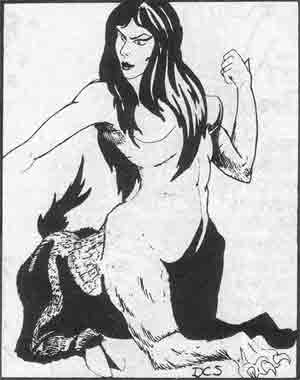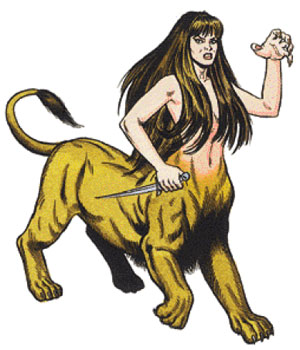Cayzle's Wemic Site
|
|
|
|
|
|
|||||
|
|
|
|
|
||||||
|
|
The Lamia [13 April 2013] The origins and evolution of a wemic-like creature.
As a fan of wemics, I have to admit that there just are not a lot of wemic resources out there on the Web. Granted, my mission is to find the ones I can and link to them, or review them, or host them here. But the good wemic stuff is not abundant. So there is always the temptation to stretch the boundaries and talk about anything that seems related. In the past, I've blogged about humans with lion heads, artificial minotaur legs, a real live ducktaur, and so on. Given the low bar I've set for notability (sorry, not even close to Wikipedia standards), I find myself amazed that I have never adequately addressed lamia. The story of the lamia starts with a Greek myth of a queen whose children are cursed and killed by the gods, and who becomes a monster that eats others' children. The mythical queen became a legendary boogieman in the Middle Ages. Check out the Wikipedia entry on Lamia for more. But what kind of monster did the lamia become? In Edward Topsell's 1658 beastiary, "The History Of Four-Footed Beasts And Serpents," the lamia appears as a four-footed creature like a sphinx, with scales, a lion's forepaws, cloven hooves behind, and a horse's tail. This lamia engraving, from 1792, clearly derives from Topsell. In Greece, lamia became female vampires, called Lamiai. And the lamia became a boogey-monster used to frighten children. In Plutarch's Lives, the ancient Roman text, there is a section on a Greek king named Demetrius, who loved a courtesan who happened to be named Lamia. The passage jokingly compares the marks made by the courtesan Lamia's lovemaking to the scars left by a lion attack. Plutarch says: When Lysimachus once in familiar conversation with Demetrius's ambassadors, showed them some deep scars which had been made on his thighs and arms by the claws of a lion, when he was shut up in the den made with him by Alexander, they laughing replied, that their master could also show upon his neck some marks of a terrible wild beast called a Lamia." That's taken from a Google Books' archive of a 1758 edition of Plutarch's Lives. John Keats' famous 1819 poem "Lamia" presents her as a kind of half serpent or snake. Here's a 1900s painting by John Waterhouse of Keats' lamia disguised as a human woman seducing a victim. You can tell she's a snake monster because of the snakeskin she's draped in, evidently. In 1858, Thomas Hood published a play based on the snake-like version of the Lamia story. The creators of the first edition D&D Monster Manual drew on these roots when they created a lamia monster for D&D heroes to fight. The first D&D lamia was heavily inspired by Topsell's beastiary. Lion forepaws? Check. Cloven hooves behind? Check. Horse's tail? Check. Human head and breasts? Check and double check. But the D&D creation made the lamia into a true "centauroid," or "taur" -- with two arms and four legs. That early D&D lamia also gave a nod to Keats, with a mention that some "noble lamia" were half snake, half human. Both varieties drew on the vampire mythology, using attacks that drained wisdom. Against heroes, dagger attacks drained wisdom; against young teen players, it was the naked boobies that did the trick. And it was this verion of the lamia that recently inspired a great Lore Sj�berg "Speak With Monsters" comic. In later editions of D&D, lamia became pure lion from the waist down, and male versions appeared (click on the eye logo to see the graphic, or just see left on this page). 4E D&D, in this as in so much else, went completely off the rails, reimagining the lamia as a fey creature that can change into a swarm of insects. Please, shoot me now. Not even worth a link. Liontaur-like lamia have popped up in other game systems too, such as World of Warcraft, Pathfinder, and in minis. A snakelike lamia is in the Final Fantasy games. Then there's this, which I just find confusing. Aug. 31, 2014 update: Fixed a broken link for the Speak With Monsters comic, since, most sadly, Lore's excellent site has died and gone to Web Heaven. |
Home | This page last modified: 28 Aug. 2014



